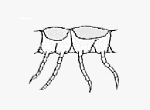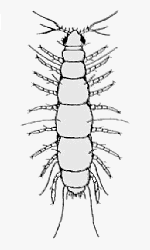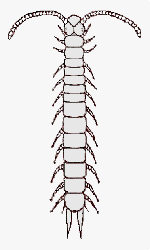
Consulting Entomologist

Tel/Fax: 01275 854224
E-Mail: [email protected]
Site Guide
Site Search
Home Page
Career Page
Insect Files
- Contents
- Bug Index
- The World of Bugs
- Classification of Bugs
- Insect Identification
- Insect Fossils
- Insect Body-parts
- Micro View of Bugs
- Insect Life Cycles
- Insect Defences
- Insects of Nailsea
- Pesticide Safety
- Bibliography
Shortcut to the main groups of insects and other arthropods...
Bug Rhymes & Poems
Links
Shop
Payments (credit/debit card)
Pauropods & Symphylids |
Class: Myriapoda Order: Pauropoda & Symphyla |
| Surviving ancestral offshoots of the centipedes and millipedes . . . . . . | |
|
|
The pauropods (Pauropoda) and symphylids (Symphyla) resemble small centipedes (Chilopoda) and share many of the structural features typical of this group. However, there are parts of their anatomy and development which suggest affinities to the millipedes (Diplopoda), and also to some of the more primitive insect groups, such as the bristletails (Thysanura and Diplura) and springtails (Collembola). In other words, they seem to be surviving offshoots of the extinct ancestral lines that eventually gave rise to the more advanced myriapods (centipedes and millipedes) and to the insects. Such animals, which may resemble the missing ancestral forms of modern groups, are often called 'missing links'. | |
|
The Pauropoda, for example, have a single pair of legs on each body segment, as found in the centipedes, but most of the body segments are partly fused along the back in pairs (see diagram on the right), so that from above each apparent segment seems to have two pairs of legs. In this respect they resemble millipedes, except that the paired-segments of millipedes have become completely fused. Thus, the Pauropoda are a sort of 'half-way' stage between the ancestral myriapods, which were probably more or less centipede-like with one pair of legs on each body segment, and the millipedes which have two pairs of legs on each apparent segment. |
 Four body segments of a Pauropod in side-view showing the fused terga or dorsal plates (shaded) of the paired-segments | |
|
|
The Symphyla, on the other hand, whilst essentially centipede-like, have numerous structural features of the head, mouthparts, abdominal segments and internal organs, more like some of the primitive apterygote insects than centipedes. Hence, there is a strong body of opinion, for example as argued by Imms (1964), that the ancestors of the insects were almost certainly myriapod-like creatures, and probably very similar to the Symphyla. The members of both groups are all tiny creatures, more less or less whitish in colour and lacking eyes. The Pauropoda are never more than 5 mm long, and generally much smaller, with branched antennae. Adults have 8-10 pairs of legs, but the young stages have fewer, usually 3 pairs at birth, increasing in number up to the full adult complement as the animals grow. As already indicated, an unusual feature of pauropods is the pair-wise fusion of most body segments, but only on the dorsal side. Hence, when viewed from above, pauropods appear have two pairs of legs on most of the apparent body segments, but from below it is clear that they actually have just one pair on each true segment. The Symphyla are generally somewhat larger than the Pauropoda, but rarely more than 10 mm long, with simple thread-like antennae. The adults have 10-12 pairs of legs, whilst the young stages have about 6 pairs at birth, again the number increasing up to the full adult complement as they grow. Symphylids have one pair of legs on each body segment and the body also has a pair of short appendages, called cerci, at the rear-end. | |
|
The Pauropoda and Symphyla are both rather obscure groups and relatively little is known about their biology and habits. They live in the soil and also under stones, in decaying wood, leaf litter and other moist places, where they feed on vegetable matter, moulds and detritus. A few symphylids are occasional pests of crops and garden plants, mainly in glasshouse soils in cold and temperate regions, but also outdoors in warmer climates. The glasshouse or garden symphylid (Scutigerella immaculata) is usually the most troublesome species. The young and adults live in the soil and eat the fine rootlets and root-hairs of plants. They may also tunnel into larger roots. Badly affected plants become stunted, and may even wilt and die. Further details of symphylid damage and its control in garden plants can be found in Buczachi & Harris (1998). | ||
|
|
|
RELATED PAGES (Other Myriapoda) | |
|
CENTIPEDES (Chilopoda) |
MILLIPEDES (Diplopoda) |
 (classification of myriapods) |
| <<< TOP | (use the back button on your web browser to return to the previous page) | TOP >>> |

